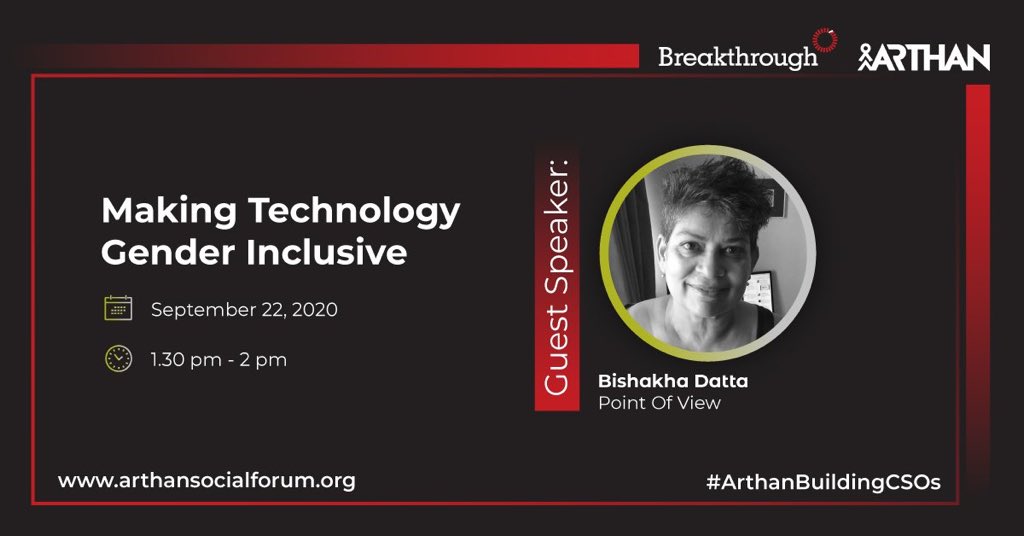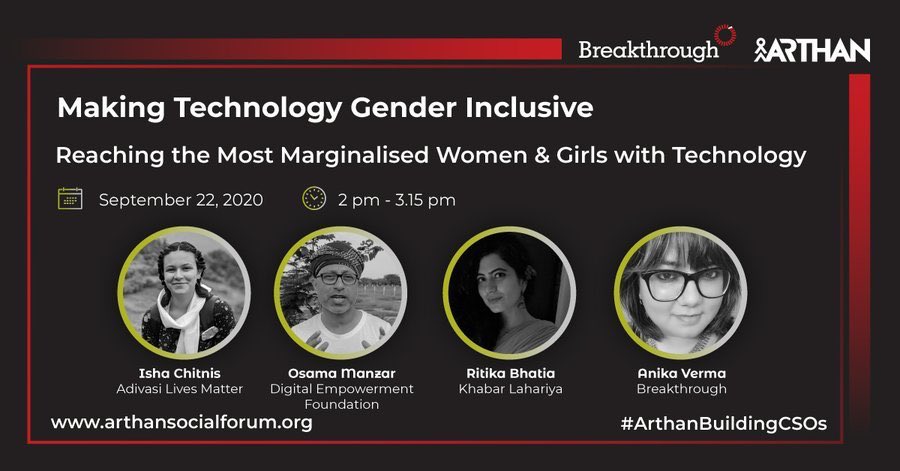This is ongoing right now! We& #39;re tweeting some of the interesting discussions coming up during the chat, check out the thread below! https://twitter.com/INBreakthrough/status/1306207202739326978">https://twitter.com/INBreakth...
When we& #39;re talking about making technology gender inclusive, let& #39;s talk mobile phones. According to @anjakovacs, mobile phones are important because of the autonomy they provide. But even after women get access to phones, there are many restrictions in terms of control.
As compared to men, women actually use phones for far fewer actions. The kind of usage that happens is really controlled and narrow for women.
@anjakovacs asks: Let& #39;s think about the above in terms of the domino effect. What does it mean for education, employment opportunities?
@anjakovacs: This above is important especially in context of COVID-19. For example, when talking about education, how does it effect teenage girls? When a family has to share a phone, teenage girls are lower in the hierarchy.
Or let& #39;s talk about domestic violence. One of the major challenge is of how to report it. How do you do it if you don’t have access or the privacy to do so?
And of course, talking about technology and women means we cannot avoid talking about the elephant in the room: online violence/harassment and women.
When we talk about online violence, @anjakovacs says: We often do not have the language to talk about harms we are seeing. We talk about data as a resource. Thus, non consensual sexual images are treated as a data but that is not how women talk about it.
At @iNetDemocracy (Internet Democracy Project), we& #39;re putting the body back into data. - @anjakovacs
While talking about how technology is gendered, @gelcarballo from @FightInequality says:
The richest people in tech are all men. That is evidence of how gendered tech is. We have gender specific needs being catered by people who don’t understand it.
The richest people in tech are all men. That is evidence of how gendered tech is. We have gender specific needs being catered by people who don’t understand it.
Gayatri Buragohain from @fattechy says: When it comes to access, even before the pandemic, there was a pattern. Giving a boy a phone is seen as a necessity. In a family with only one smartphone, girls don& #39;t have access to it.
Control over sexuality of women remains one of the biggest barriers with tech. Because of this, access will remain challenging. Technology needs to be seen as emancipation. - Gayatri Buragohain, @fattechy
To this, @urvashigandhi from @INBreakthrough adds: This reminds me of the idea of & #39;contract of purpose& #39;: a woman has to show purpose of venturing out to any space outside the home.
Independent journalist @nehadixit123 talks about technology from the perspective of the media: As per market research, millennial women are not interested in hard news, but in positive stories, human interest stories...
... algorithms are working in a way that even urban women who have access to technology are only accessing some things.
During #COVID19 and the rise in domestic violence, all the campaigns were online. So many women did not know what was happening. - @nehadixit123
With PDS system (public distribution system), women trying to access ration have no access to phones and OTPs meaning they lose access to rations. This has led to hunger deaths. - @nehadixit123
So, how do we address these inequities structurally during crisis situations like the current pandemic?
One of the biggest challenges in the past few months is to be able to recognise what is real and what is not. Entertainment molds the way we think. Without access to tech, we can’t even think of going to that layer. - Gayatri Buragohain, @fattechy
The spaces to engage critically with tech are shrinking.- Gayatri Buragohain, @fattechy
Technology often reinforces stereotypes and barriers: both eco-social and cultural barriers. We need more role models for girls & women in tech. More online community and spaces that will work to empower women. - @gelcarballo, @FightInequality
Poverty matters but sexuality overrides everything. The gender gap in tech even for high income categories speaks about the power of social norms. Even if women have access, what is it that are actually allowed to do with that access? - @anjakovacs, @iNetDemocracy
Shared devices are a good solution but how is this sharing done is important. Generally, the power dynamics will always creep in in case of shared devices. - Gayatri Buragohain, @fattechy
@nehadixit123: We need more women over 50 accessing technology and online literacy for these women. For a a lot of teachers, this remains a vacant area.
@nehadixit123: In this, post-truth world, facts have no value. Mainstream media coverage has become about opinions. This has also become the revenue model. If there is more ground reporting, women from the ground will get a voice and their voices will figure.
@nehadixit123: For example: Several UN bodies have comes up with a report about how #Covid_19 has impacted the reproductive health of women. Women cannot access hospitals but have we seen any coverage around this in the media?
Comprehensive sexuality education in school, beyond technology, is an example of what needs to change in the larger landscape. It’s not a step by step approach, where we first address the larger issue and then get technology. - Gayatri Buragohain, @fattechy
The lens for media has become very urban rich. The automobile industry employs men, but parts that reach are made by women. This conversation is completely missing. - @nehadixit123
@gelcarballo: Women are generally seen as consumers of technology. It is important for women to be recognised as producers and thinkers behind technology.
@FightInequality
@FightInequality
@gelcarballo: Illiteracy has not been addressed by the world of technology. If it wanted to address it, it could. Who makes the technology matters a lot. It is again a question of power and privilege.
@FightInequality
@FightInequality
We’ve begun our next session for today! We will be posting highlights from the session on this thread for you to follow. @whatisdapoint @busydot @OsamaManzar @DEFindia @KhabarLahariya @AdivasisMatter
@busydot: Ciswomen, trans people, marginalised people do not get to use technology on their own terms but on the terms of others - parents, family, society etc.
@busydot: During this pandemic, digital technology particularly mobile phones have emerged as life saving equipment. Be it help services, education, we needs some kind of digital device to access any of them. However, access to digital devices is conditional for certain genders.
@busydot: A lot of these gender to rules are actually about sexuality. When we spoke to women they said that bhai log are the ones who restrict- from going out, meeting friends, maybe flirting with someone. And, all of this in the name of keeping them safe.
@busydot: Need to think more expansively of tech we use while we’re talking about marginalised communities because many of them are not on mainstream platforms like Instagram etc & find such ecosystems alienating. We need to enter ecosystems which they use & are comfortable with.
@busydot: Bringing tech to marginalised communities is not just a question of technology but primarily a social question which we need to solve at its roots by chipping away constantly at gender and social norms.
Isha Chitnis from @AdivasisMatter: First and foremost, include adivasi and tribal communities in the conversation when we’re looking for the solution.
There was no network, electricity even before the pandemic. Instead of finding solutions for now, we have to look for a broader perspective. The onus shouldn’t be on adivasi & tribal communities to find innovative ways. As a society, we should figure it out.-Isha @AdivasisMatter
Ritika from @KhabarLahariya: People ask why do women need phones when they’re only going to stay home? But also when you ask why can’t women go out, the reason given is that they don’t have phones. This is a vicious cycle.
@KhabarLahariya reporters are all marginalised women. With them occupying this space, people in villages are now recognising that women can be reporters. Dalit women can be reporters. It’s imp to occupy the online & offline real estate which our reporters have been doing.- Ritika
@OsamaManzar: We are patriarchal even in making policies. If Bharat net is going to connect panchayats, we’re not thinking about connecting women. Need policies to ensure greater digital inclusion for women, like ensuring that institutionally elected women have digital access.
@OsamaManzar: Internet Saathi is a project where women get a mobile and they use it for teaching and learning. When we go with such a scheme, it is unlikely that people will refuse. At the very least, the digital device reaches the hands of women.
@OsamaManzar: When we plan our programmes for working on this issue of inclusive technology, our planning itself needs to have equitable access built into it. @DEFindia
@AdivasisMatter makes a conscious effort to pick at least 50% women if not more for our trainings on content creation. When they got smartphones, the stories that came made sense because women interview more women, we wanted a perspective on the lives of adivasi women. - Isha
Isha Chitnis, @AdivasisMatter: Women loved creating content because they were able to decide and take a call. Social media is filled with men and Savarna voices. When adivasi women realise that their voice has a place on social media, they create more.

 Read on Twitter
Read on Twitter



